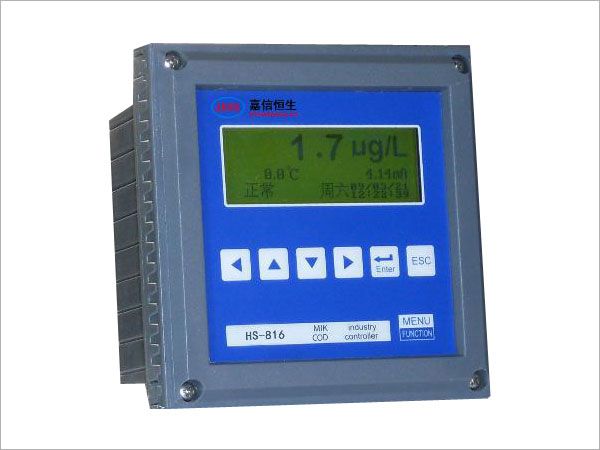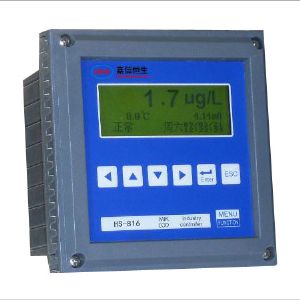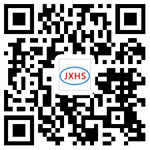
HS-816 COD monitor
The COD online monitor is used for online automatic continuous analysis and detection of total lead in industrial wastewater, surface water, drinking water, seawater and industrial production process control. Water sample, potassium dichromate digestion solution, silver sulfate solution (silver sulfate is added as a catalyst to oxidize linear fatty compounds more efficiently), and concentrated sulfuric acid mixture is heated to 175 ° C, organic matter in dichromate ion oxidizing solution After the color changes, the analyzer detects the change in the color and converts the change into a COD value. The amount of dichromate ions co
Main feature
★ Unique design makes this product have lower failure rate, lower maintenance, lower reagent consumption and higher cost performance than similar products.
★Optical components: Select the dual beam that is rarely used in domestic online monitoring instruments, and the detection is not affected by various environmental factors. Automatically correct system errors and improve instrument measurement accuracy, stability and repeatability.
★ Select valve components: imported components from the United States, Japan or Germany. The international mainstream fluid components have a smaller dead volume and simpler operation.
★ Metering component: Accurate metering of reagents through visible photoelectric system, which overcomes the quantitative error caused by wear of peristaltic pump tube; at the same time, it realizes accurate quantification of trace reagents, only 1 - 5 ml per dose, greatly reducing reagents Usage amount.
★ Injection assembly: peristaltic pump suction, there is always an air buffer between the reagent and the pump tube to avoid corrosion of the pump tube.
★ Sealed digestion component: high temperature and high pressure digestion system accelerates the reaction process and overcomes the corrosion of corrosive gases in the open system.
★ Reagent tube: It adopts imported modified PTFE transparent hose with a diameter of more than 1.5mm, which reduces the probability of water sample clogging.
★Signal processing: The instrument adopts the imported high-precision analog-to-digital conversion chip, which greatly enhances the scalability of the core board, can adapt to a variety of use environments, and makes the operation of the instrument easier and more user-friendly.
★ Temperature control: The imported temperature measuring component is used to form a precise temperature control system, and the temperature compensation technology is adopted to overcome the influence of temperature drift and ensure that the sample reaction conditions are more in line with the requirements.
★Software advantage
1. The entire software system framework and external facilities of the instrument make human-computer interaction easier and the function application is more perfect;
2. For different water quality at special sites, the pollution caused by the instrument measurement process can be set from time to time, which greatly reduces the instrument failure rate caused by this problem and makes the measurement data more accurate;
3. The instrument has automatic calibration mode. After automatic calibration, the instrument returns to the automatic mode and runs according to the user-set parameters. It does not require full monitoring by the staff, greatly reducing maintenance time and improving maintenance efficiency.
4. The instrument measurement water sample is divided into online mode (ie automatic mode) and offline mode (ie manual mode). In the offline mode, the calibration tube is used for measurement. It is not necessary to take the water sample tube out of the sampling port or the sampling cup, which makes maintenance more convenient. ;
5, the instrument can store 200,000 pieces of data, and the data can be exported by one button;
6. The instrument online mode (ie automatic mode) and offline mode (ie manual mode) data are stored independently, offline mode data is not uploaded to the data acquisition instrument, which avoids the impact on the uploaded data during instrument maintenance.
The main technical parameters
★ Method basis: National Standard GB11914-89 "Water Quality - Determination of Chemical Oxygen Consumption - Potassium Dichromate".
★ Measurement range: 10-5000 mg/L COD.
★ Accuracy: ≥100mg/L, no more than ±10%; <100mg/L, no more than ±8mg/L.
★ Repeatability: ≥100mg/L, no more than ±5%; <100mg/L, no more than ±6mg/L.
★ Measurement period: The measurement period is ≥ 20 minutes. According to the actual water sample, the digestion time can be arbitrarily modified from 5 to 120 minutes.
★ Sampling period: time interval (arbitrarily adjustable from 20 to 9999min) and hourly measurement mode.
★ Calibration period: 1 to 99 days can be adjusted at any time.
★ Maintenance period: usually once a month, about 30 minutes each time.
★ Reagent consumption: less than 1 yuan / sample.
★ Output: RS-232, RS485, 4-20mA, 0-5V
★ Environmental requirements: indoor temperature adjustable, recommended temperature +5 ~ 28 ° C; humidity ≤ 90% (no condensation).
★ Power: AC230±10%V, 50±10%Hz, 5A.
★ Size: height 1500 × width 550 × depth 450mm.
★ Others: Abnormal alarms and power outages will not lose data. Touch screen display and command input. After abnormal reset and incoming call after power failure, the instrument automatically discharges residual reactants and automatically resumes working condition.
CODcr related background
Overview:
Chemical oxygen demand (COD) is one of the main indicators of water pollution and an important parameter for water quality monitoring. It is of great significance to control and control the chemical oxygen demand of sewage in time for the prevention and control of industrial wastewater. The methods for determining COD in water are permanganate index method and potassium dichromate oxidation method (CODcr). The former is suitable for the analysis of groundwater and clean surface water and drinking water, while the analysis of industrial wastewater and domestic sewage is mostly used. CODcr method. However, due to the long cycle of CODcr analysis, energy waste is greatly limited by reflow equipment, and batch analysis is not possible. Secondly, the use of mercury salts, silver salts, chromium salts, etc. will inevitably cause secondary pollution to the environment. To this end, it has become a goal of people to explore a method of rapid improvement and reliability.
definition:
Chemical Oxygen Demand (COD) is a chemical method for measuring the amount of reducing substances in a water sample that need to be oxidized. Under certain conditions, the amount of oxidant consumed by the reducing substance (reducing substances in water, various organic substances, nitrites, sulfides, ferrous salts, etc.) in 1 liter of water sample is used as an indicator. The amount of milligrams of oxygen required, expressed in mg/L, is converted to the total amount of oxygen required per liter of water sample. It reflects the extent to which water is contaminated with reducing substances. This indicator is also used as one of the comprehensive indicators of the relative content of organic matter.
harm:
High chemical oxygen demand means that the water contains a large amount of reducing substances, mainly organic pollutants. The higher the chemical oxygen demand, the more serious the organic pollution of the river. The source of these organic pollutants may be pesticides, chemical plants, organic fertilizers, etc. If left untreated, many organic pollutants can be deposited by the sediment at the bottom of the river and cause long-lasting toxic effects on aquatic organisms in the next few years. After a large number of aquatic organisms die, the ecosystem in the river is destroyed. If people feed on the creatures in the water, they will absorb the toxins in these organisms and accumulate in the body. These poisons often cause carcinogenic, teratogenic and mutagenic effects, which are extremely dangerous to humans. In addition, if irrigation is carried out with contaminated river water, plants and crops will be affected, and growth will be poor, and people will not be able to access these crops.
CODcr measurement principle and reference standards:
Based on the classical standard method, potassium dichromate oxidizes organic matter, hexavalent chromium forms trivalent chromium, and the COD value of the water sample is determined by the relationship between the absorbance of hexavalent chromium or trivalent chromium and the COD value of the water sample. Using the above principles, the most important representative method in foreign countries is the US Environmental Protection Agency EPA. Method 0410.4 "Automatic Manual Colorimetric Method", American Society for Testing and Materials ASTM: D1252-2000 "Method for Determination of Chemical Oxygen Demand in Water B - Sealed Digestion Spectrophotometry and International Standard ISO15705-2002 "Determination of Water Quality Chemical Oxygen Demand (COD) by Small Sealed Tube Method". China is the unified method of the State Environmental Protection Administration, "Fast closed catalytic digestion method (including spectrophotometry)."
Interference and elimination during CODcr measurement:
The reducing substances in water usually have chloride ions, nitrites, sulfur ions, etc. The presence of these ions affects the accuracy of the chemical oxygen demand measurement results and therefore needs to be eliminated.
1. Interference and elimination of chloride ions Chloride ion is one of the main interference factors in the determination of chemical oxygen demand. Since potassium dichromate can completely oxidize chloride ions, the consumption of potassium dichromate by chloride ions makes the measurement result higher than the actual value. At the same time, due to the addition of silver sulfate as a catalyst, chloride ions will precipitate with silver ions to form silver chloride, which will poison the catalyst, thereby consuming silver sulfate to form silver chloride precipitate, and the silver chloride precipitate will also be oxidized by potassium dichromate. As the chloride ion concentration increases, the chemical oxygen demand also increases, making the measured result higher than the theoretical value.
Elimination method:
(1) Mercury sulfate masking to eliminate interference. Add mercury sulphate to the water sample to eliminate interference, and mercury sulphate should be added before other reagents. Chloride ion and mercury sulphate form [HgCl4]2- which is difficult to dissociate and soluble, which can eliminate chloride interference. However, due to the high toxicity of mercury sulphate, it is harmful to the environment and human body and produces secondary pollution. In recent years, there are many studies on the determination of chemical oxygen demand by mercury-free salt method. In the mercury-free salt method for chemical oxygen demand in wastewater, MgSO4 is used as a catalyst, and Ag2SO4 is a masking agent for chloride ions, which eliminates secondary pollution of mercury. .
(2) Dilution elimination interference method. It is possible to eliminate the interference of chloride ions by diluting the water sample. It is suitable for high chemical oxygen demand (COD>300mg/L) and high chloride ion concentration (Cl-concentration is greater than 2×104mg/L) water sample analysis. For water samples with lower chemical oxygen demand, such as less than 100mg/L, the error of this method is large, and other methods should be considered.
(3) Silver nitrate precipitation elimination interference method. When the chemical oxygen demand of the water sample is low and the chloride ion content is very high, the precipitation of silver nitrate is added to eliminate the chloride ion in the water sample, and then the measurement result is stable, reliable and reproducible. Low chemical oxygen demand high chloride interference interferes with this particular problem and provides a viable solution.
2. Interference and elimination of nitrite The nitrite interference mainly consumes the amount of potassium dichromate, which makes the measurement result high. It can be eliminated by the addition of sulfamic acid, but the sulfamic acid is deliquescent and is not resistant to storage, which limits its application. It has been found through research that sulfamic acid can mask nitrite because the amino group is in action, so a more stable reagent ammonium sulfamate (not deliquescent) can be used as a masking agent to determine the accuracy of potassium dichromate. higher.
3. Interference and elimination of sulfur ions Sulfur ions can be oxidized by potassium dichromate, so that the measured value of chemical oxygen demand is high. The elimination of sulfur ion interference can be determined by pre-determining the original concentration of the sulfur-containing water sample chemical oxygen demand, and then calculating the oxygen consumption from the chemical oxygen demand result by calculating the quantitative oxidation. The amount.
| Previous:HS-817 type flue gas monitor | next:Quality Management System Certificate |









